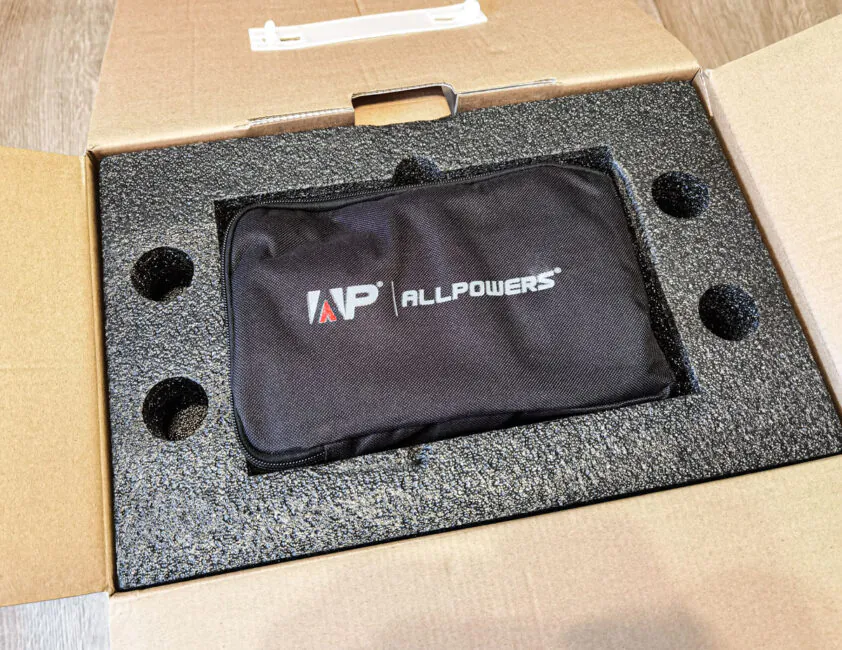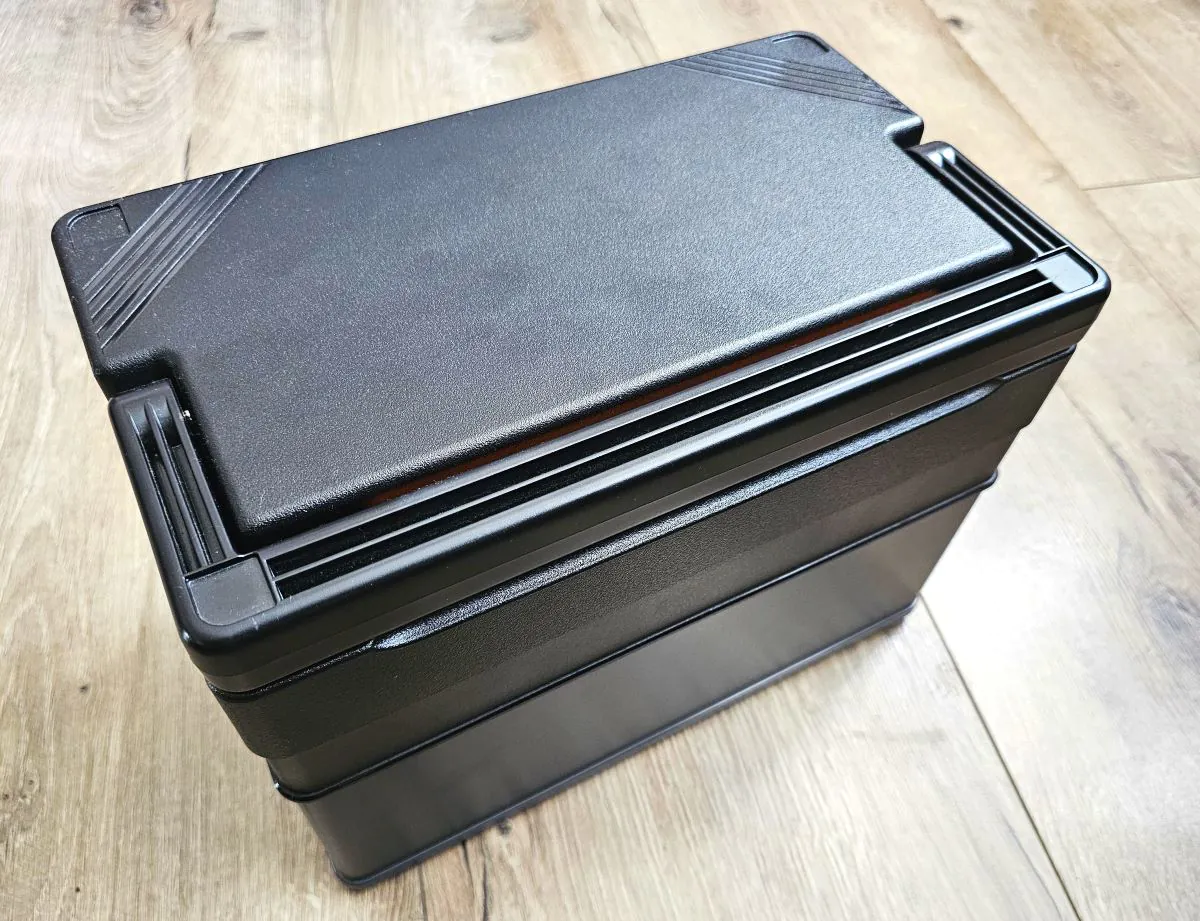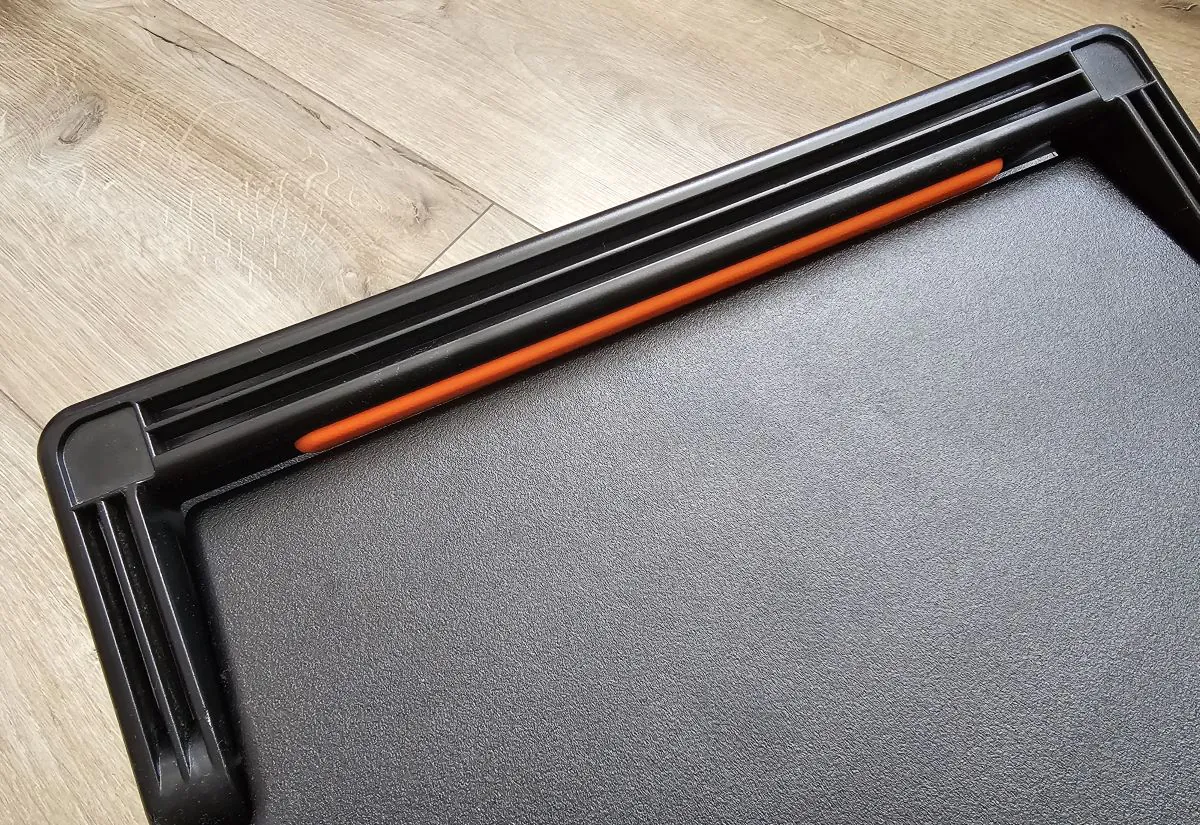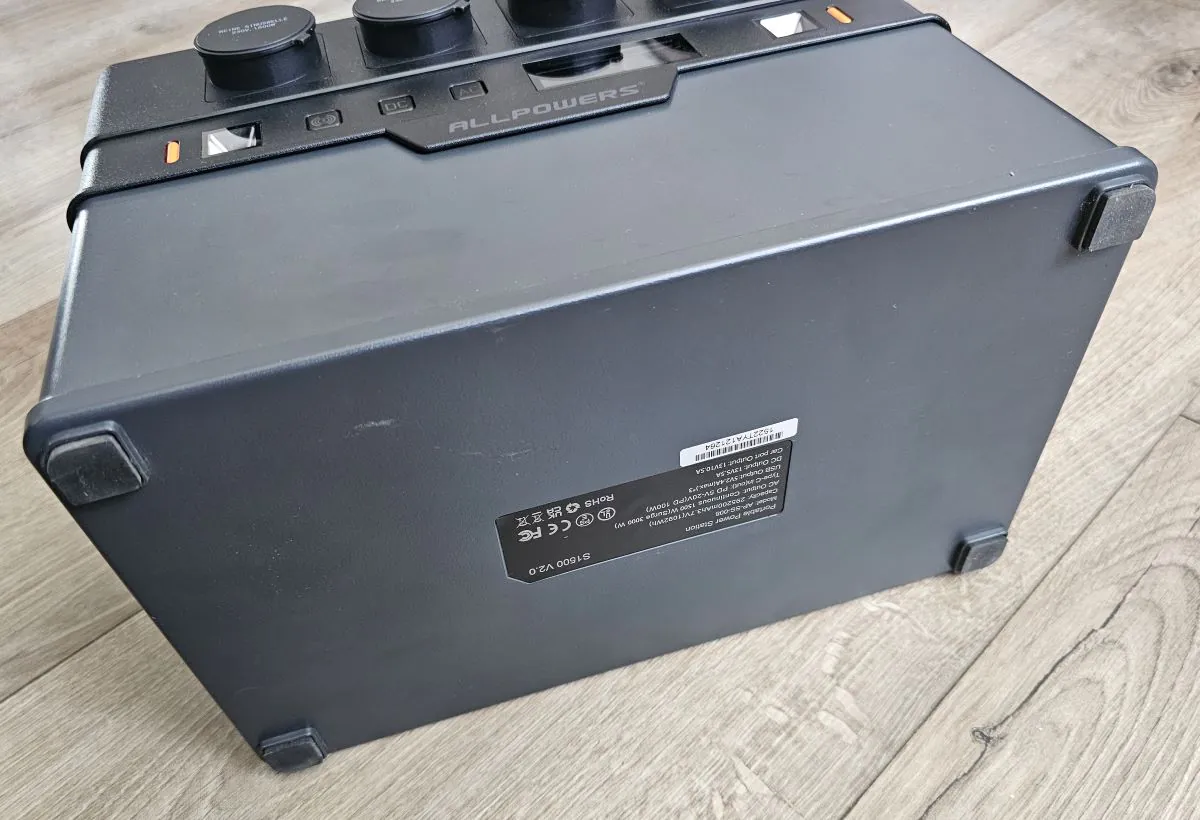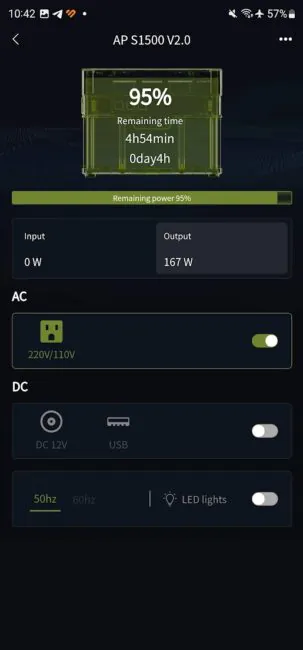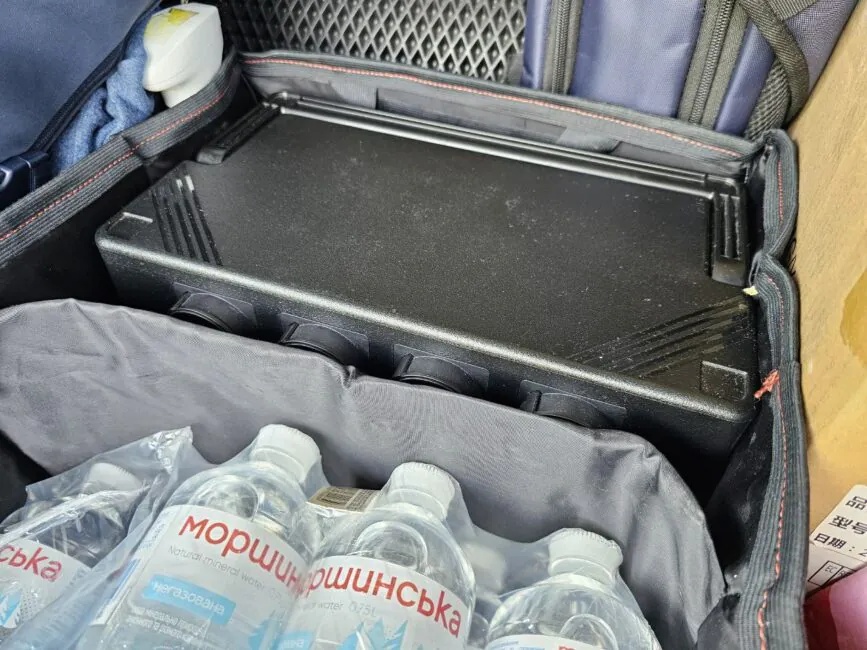© ROOT-NATION.com - Use of content is permitted with a backlink.
Over the past year, backup power devices such as generators, charging stations or simple pavement banks have become firmly entrenched in Ukrainians’ households. Although, despite the best efforts of the Russian military, a full-fledged energy apocalypse has not occurred in Ukraine, everyone nevertheless remembers the rather long, difficult period of emergency and stabilisation power outages in the summer and autumn of 2022, when power was supplied to consumers for literally 4-5 hours a day. During that time, the ALLPOWERS S1500 (AP-SS-008) electric power station was a real salvation for me. Today, I’m going to tell you what it can do, share my impressions of how it works, and think about how a similar device would be useful to me in civilian life, after the victory.
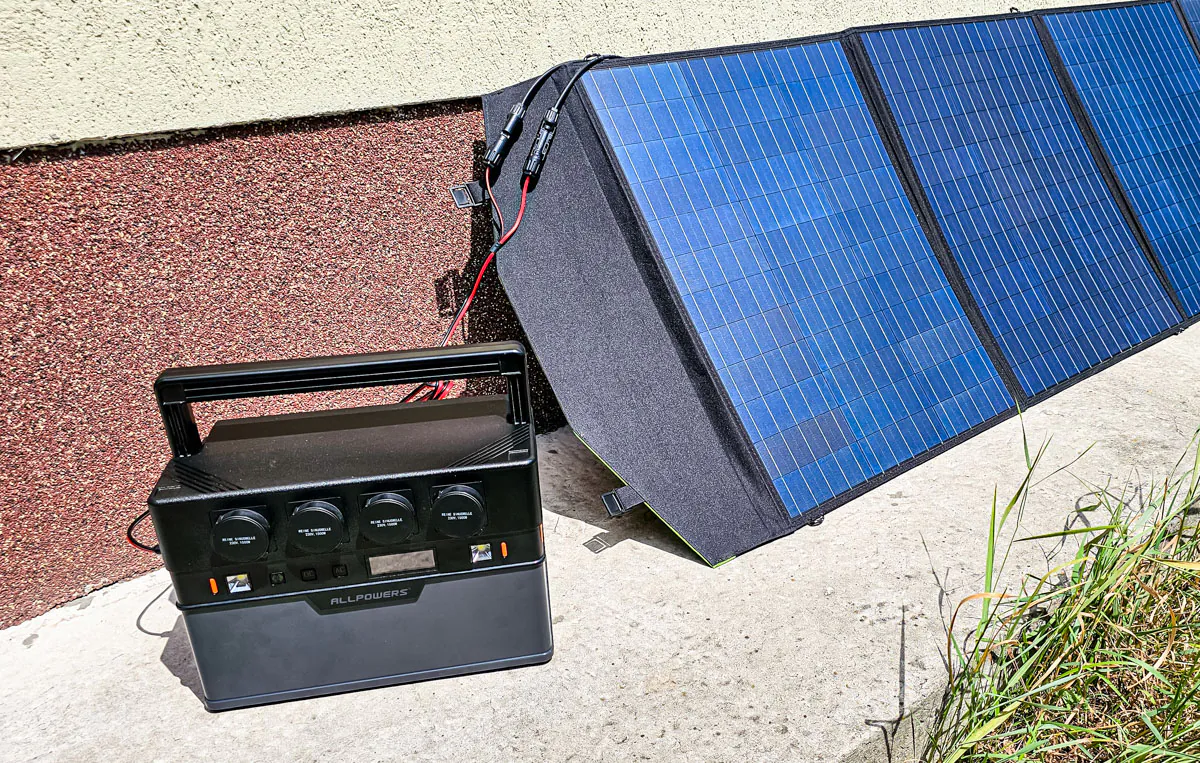
Main features and functionality of ALLPOWERS S1500 (AP-SS-008)
What are charging stations for anyway, and how are they different from pavement banks? It would seem that it’s the same as a battery, only with a higher capacity? But not quite. The main difference, of course, is the built-in inverter for converting DC to AC and the availability of 110 or 220 V outlets, so you can use the charging station to power ordinary household appliances. That is why such devices would be correct to call not chargers, but power stations; in English it is exactly so – Power Station. But in the Ukrainian market the name “charging station” is traditionally used, so I will stick to this terminology in the review.
What are charging stations for anyway, and how are they different from pavement banks? It would seem that it’s the same as a battery, only with a higher capacity? But not quite. The main difference, of course, is the built-in inverter for converting DC to AC and the availability of 110 or 220 V outlets, so you can use the charging station to power ordinary household appliances. That is why such devices would be correct to call not chargers, but power stations; in English it is exactly so – Power Station. But in the Ukrainian market the name “charging station” is traditionally used, so I will stick to this terminology in the review.

The station can also be charged from solar panels and via a USB-C port that supports Power Delivery. Most usefully, different sources can be combined during this process to speed up charging. For example, use simultaneous charging from the included PSU and, via USB-C, from charging a regular smartphone. The main thing is not to exceed the recommended settings for the total charging power.
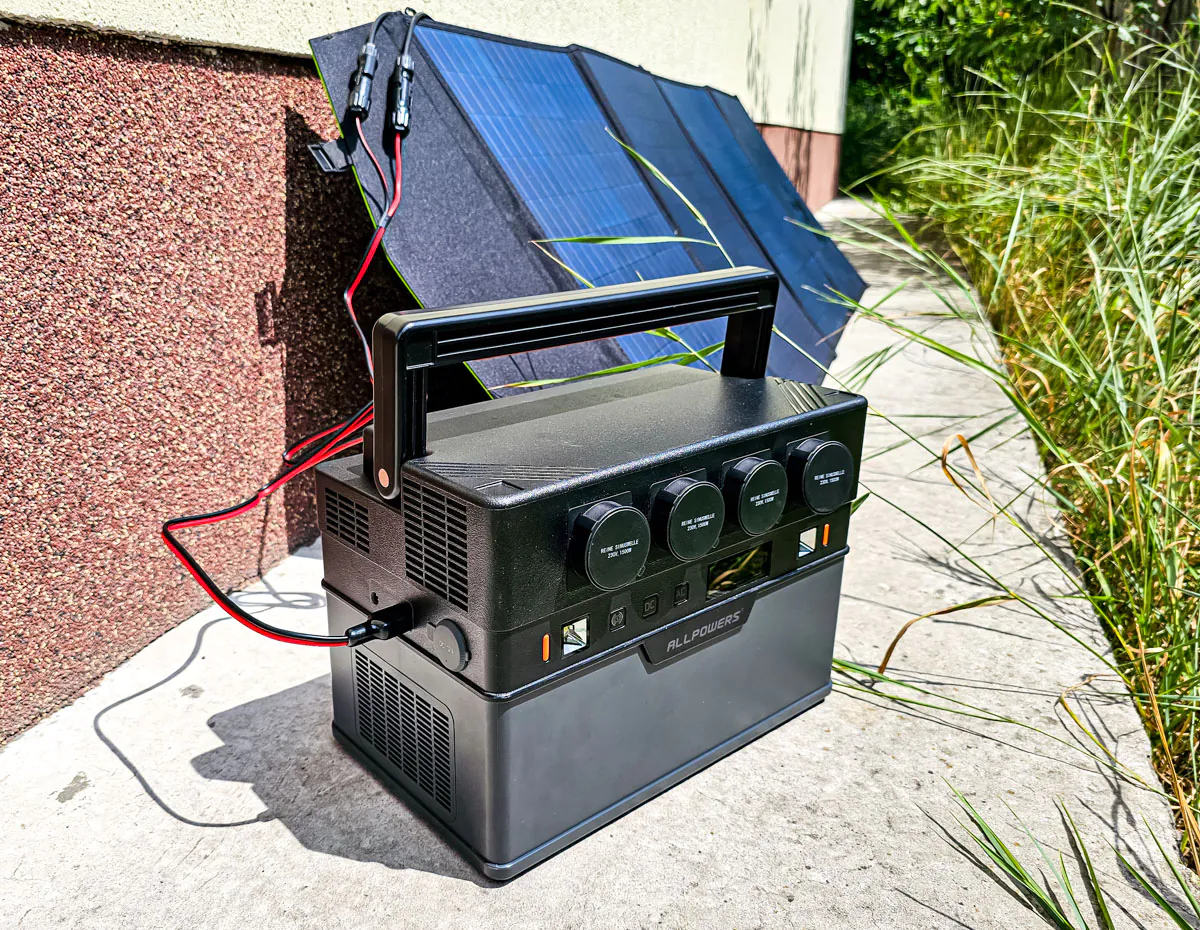
As for the ALLPOWERS S1500, the station can charge itself and charge, power other appliances and devices at the same time.
In any case, before using the unit, I advise you to learn all the nuances of the charging process of your station using the user manual.
ALLPOWERS S1500 (AP-SS-008) main features
| Battery capacity: | 1092 Wh / 295200 mAh (Li-ion) |
|---|---|
| Input: | AC Input (300 W) Solar Panel Input 500W(MPPT 12-65V 300W max) DC Input(12-65V 300W max) USB-C Input (PD 100W max) AC Input + USB-C Input (400W max) |
| Output: | 4× AC Output 1500 W (3000 W peak power) 100/110/220/230/240 V sinusoidal current 3× USB-A Output 5 V 2.4 A USB-C Output 5V 5A, 9V 5A, 15V 5A, 20V 3A (PD 100W) 2× DC Output (5.5×2.5mm) 12 V, 5.5 A 1× Car socket 12V, 10.5A |
| Dimensions: | 320×220×190 мм |
| Weight: | 10 kg |
| Special features: | Bluetooth for smartphone connection, mobile app 2× LED lights Car charger |
Positioning and price
The ALLPOWERS S1500 charging station is in the mid-range price segment. That is, the cost will be noticeably lower than the stations of more well-known brands like EcoFlow or Bluetti. As for the line of ALLPOWER stations, the model is positioned as medium, closer to the top, there are only 3 models higher – S2000 (2000W 1500Wh), S2000 (Pro 2400W 1500Wh) and R4000 (4000W 3600Wh). To find out more about the range of stations, visit the official website.
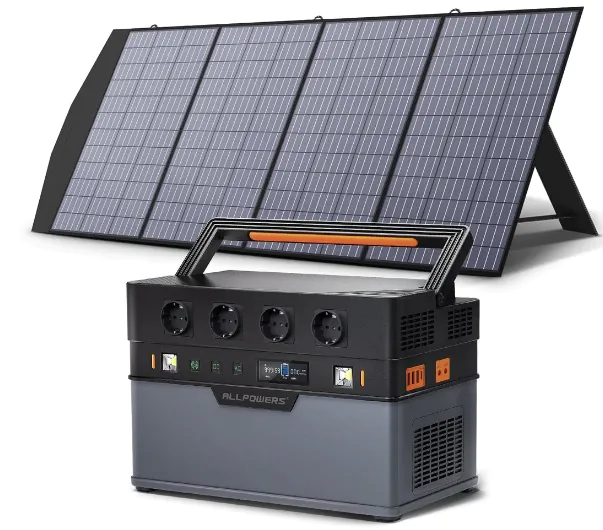
As a bonus for readers of this review, we offer our 20% discount code when you buy products from the official website: NVSA9PPGP9HN
The ALLPOWERS S1500 is available from the official European online shop for the standard price of 899 EUR. Also noteworthy is the offer to buy the station together with 200W solar panels at 1189 EUR. How the pair work together, I will tell you later – in the next review.
Supply package
The station is delivered in a double pack. On the outside there is a box of thick, coarse grey-brown perforated cardboard. There is a white box with labelling, specifications and a plastic carrying handle. Inside, the station is securely packed in foam polymer holders. Also included is a large charger unit in a soft pouch, a power cord and a paper operating manual.
Design, materials, build
The design of the ALLPOWERS S1500 powerpack is very basic – a simple parallelepiped with a folding handle.
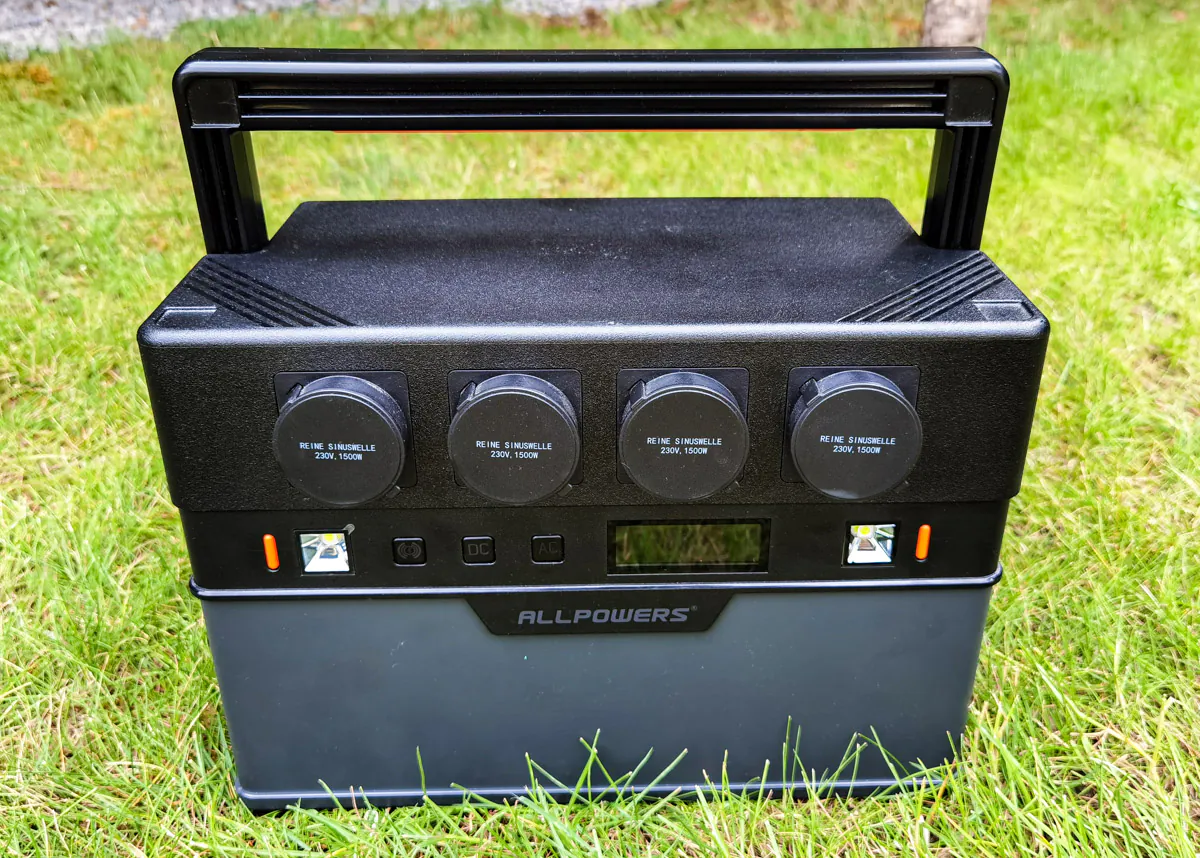
On the one hand, the appearance is not as impressively futuristic as some competitors, but on the other hand, it is a compact solution that takes up minimal volume when transported.
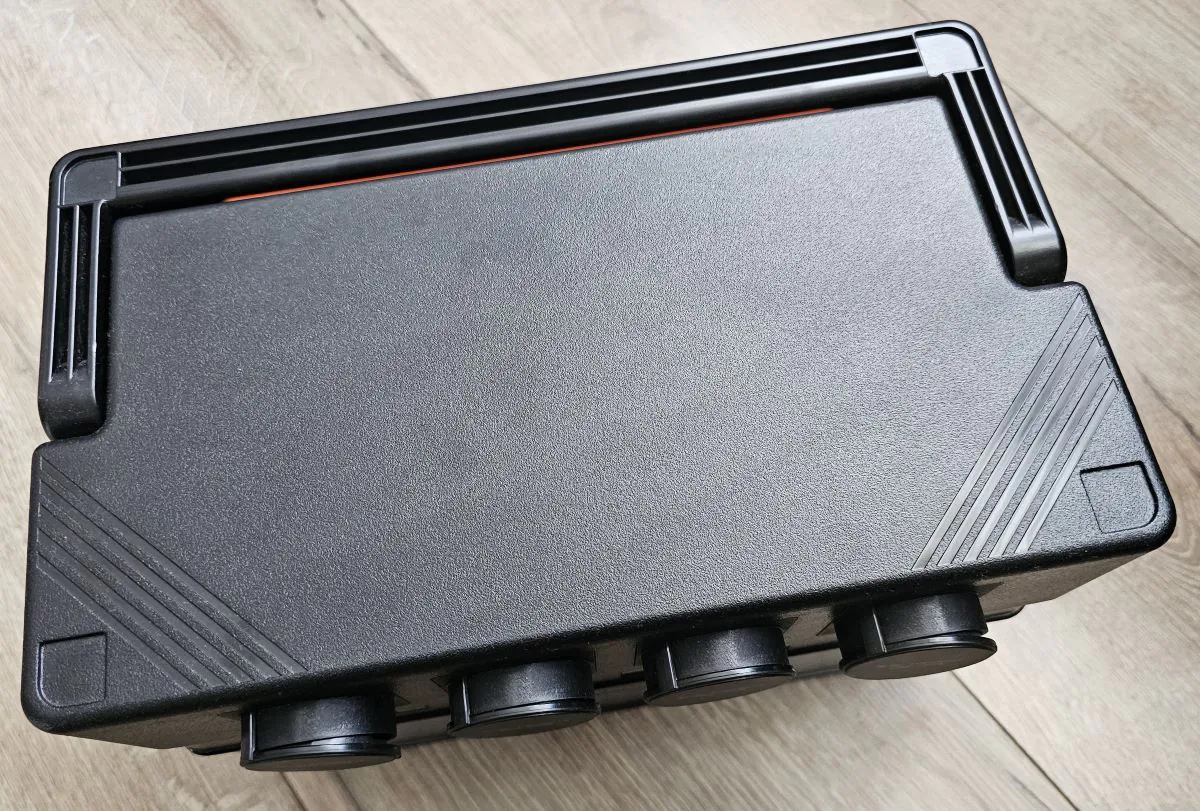
Because handles that don’t fold up and stick out simply take up unnecessary space and obstruct the compact folding of other things in the car. And when you are, for example, in an emergency to evacuate, the boot of the car is not big enough for all the things you need. And even remembering our camping trips before 2014 by car with tents to the Crimea, I remember how there was always not enough space for luggage. So, to me, this simplicity of form is the best option in terms of practicality.

When it comes to materials, they are well chosen, as they are for camping equipment. The casing is made entirely of a scratch- and shock-resistant, durable matt plastic. The main colours are black and grey with orange inlays. The handle also feels extremely sturdy and has an orange coloured rubber insert at the bottom to improve grip when carrying the station. In addition, this insert ensures that the handle is locked in the folded position. Overall, the construction is well assembled and feels secure.
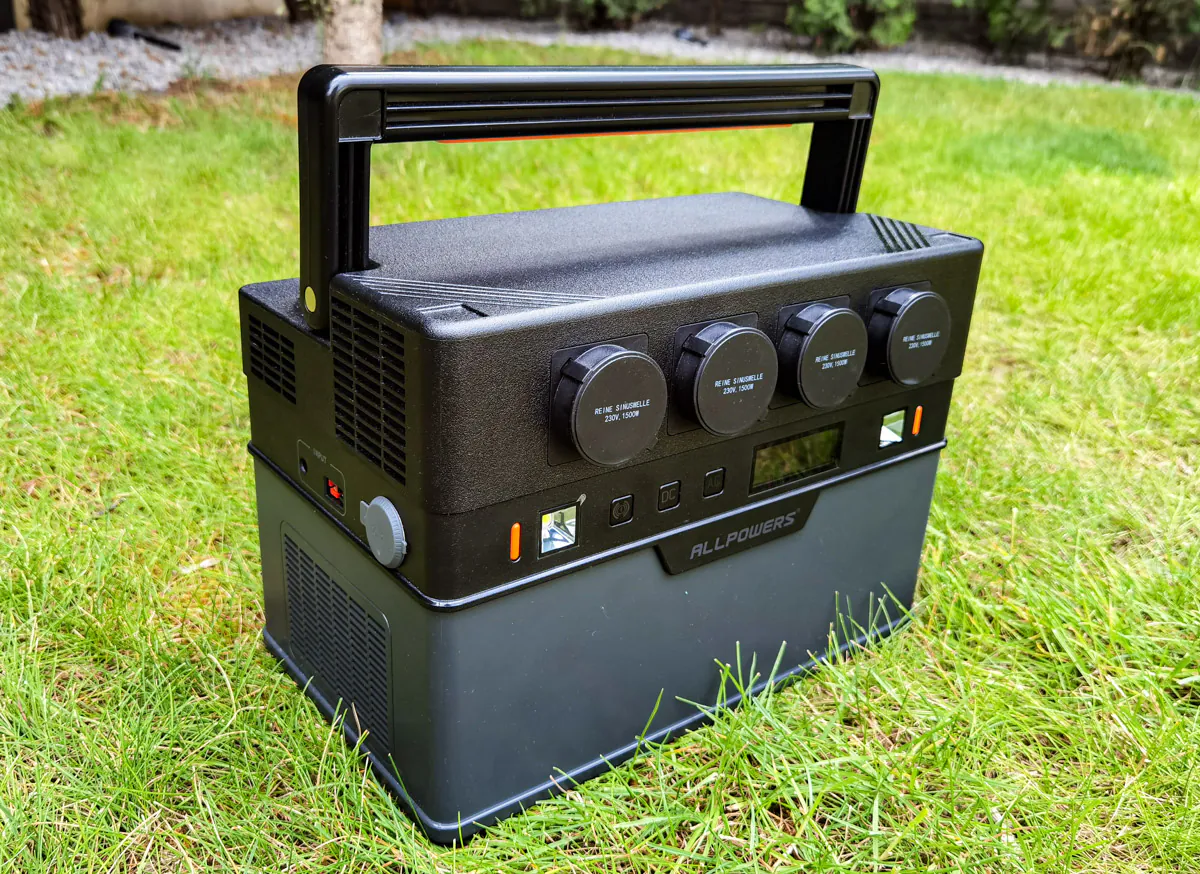
Layout of elements and interfaces
Let’s take a closer look at the station from all sides. On the front we see 4 230 volt AC sockets, 2 emergency lights with orange control buttons, 3 square buttons – switch on the station and activate the Bluetooth module, switch on DC and AC output mode, and an information LED display.
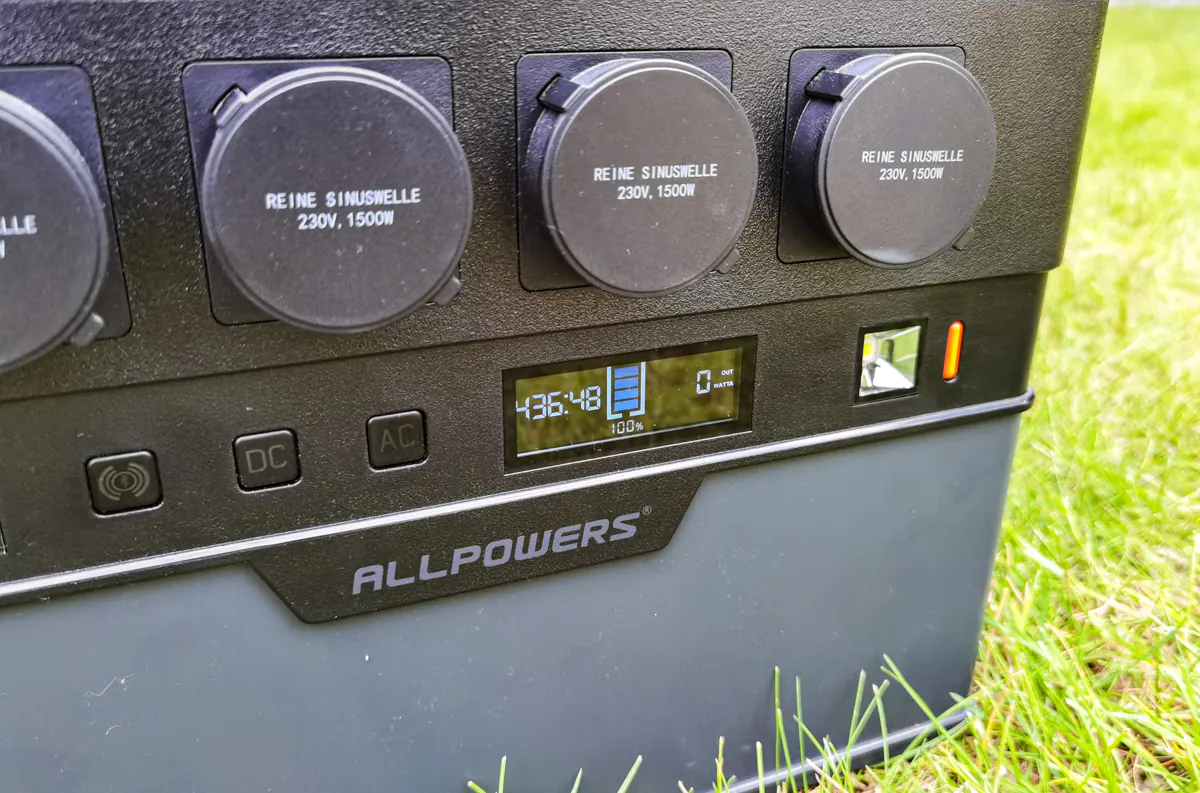
On the right-hand side are two DC interface boxes, which are marked in orange. The first has three USB-A ports and one universal USB-C port, which can be used both as an output to power or charge compatible devices and as an input to charge the station itself from adapters up to 100W. The second unit contains two 12.5V coaxial connectors. There are also three ventilation grilles, one of which has an active fan at the bottom to cool the battery pack.
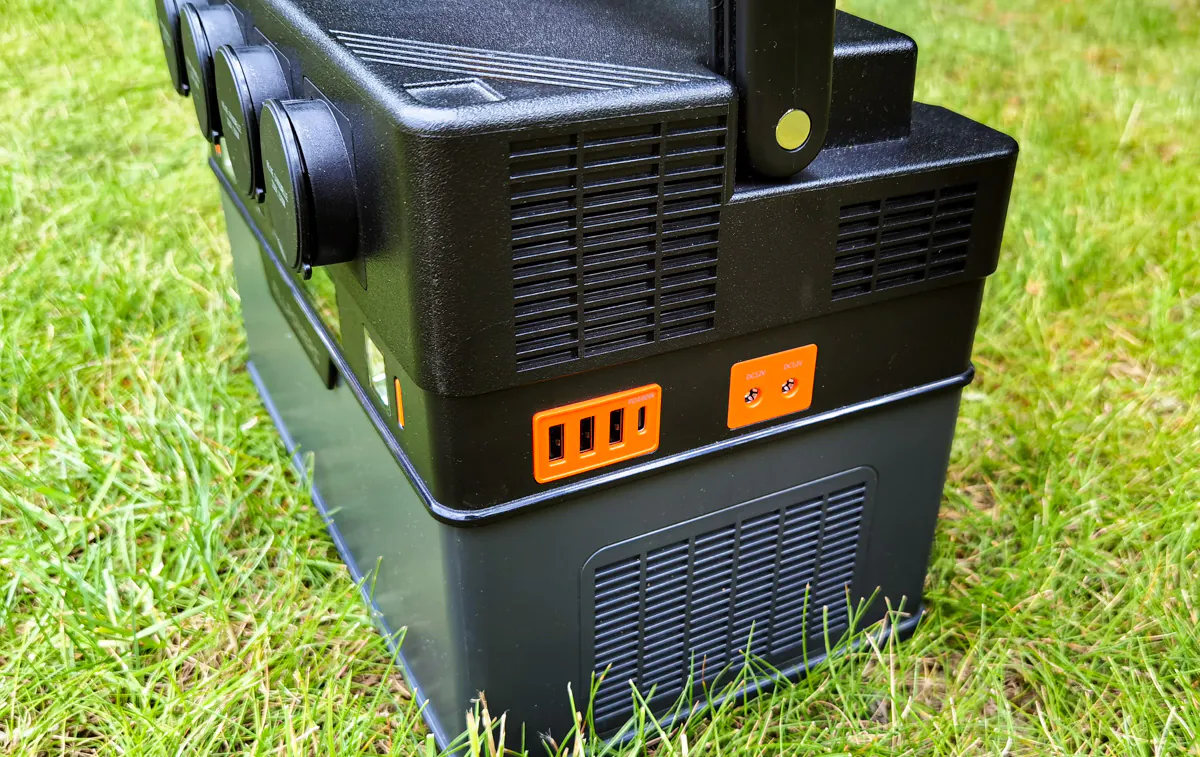
On the left is the input for the supplied charging adapter, 2 Anderson-type sockets for charging the station from solar panels, and a round 13V car socket. There are also three ventilation grilles, the top one with a fan for cooling the electronic control unit.
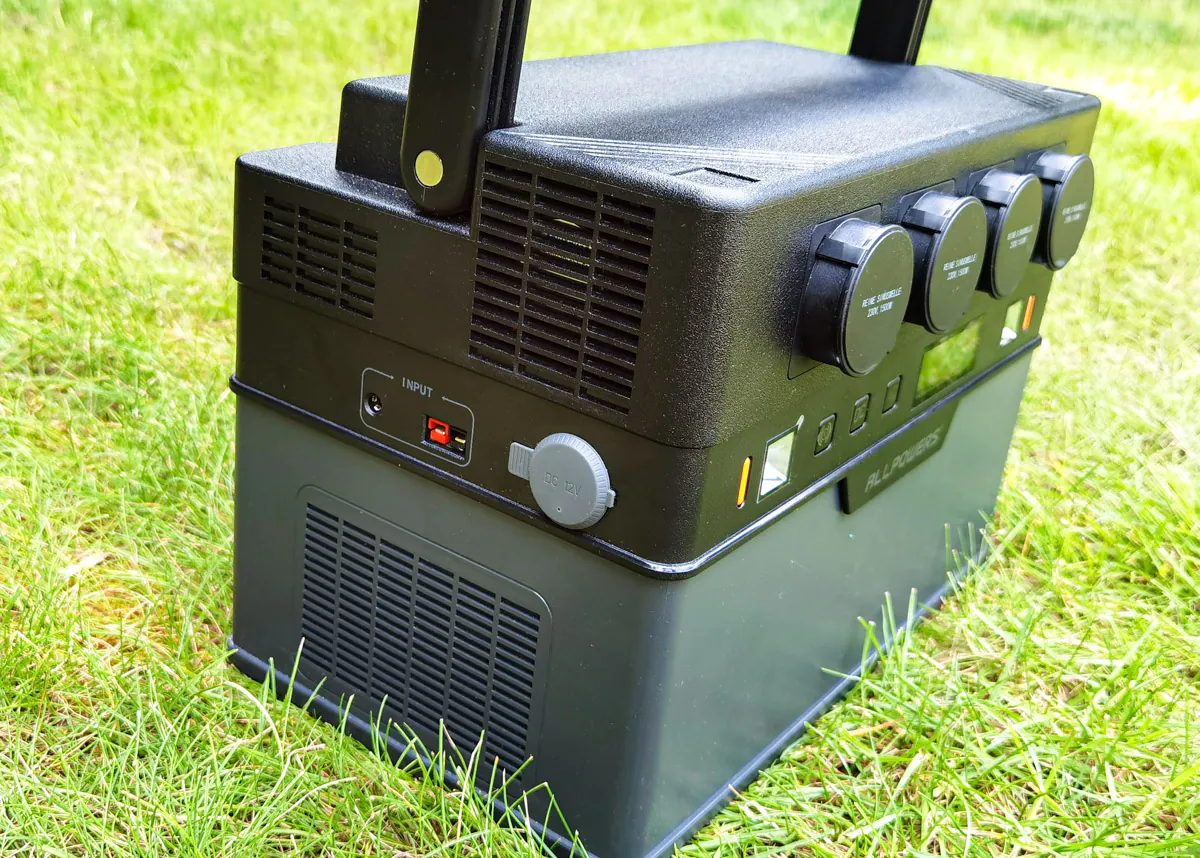 On the top is a folding carrying handle. Nothing on the back. The bottom has four rubber feet on the corners and a sticker with general information, model specifications and serial number.
On the top is a folding carrying handle. Nothing on the back. The bottom has four rubber feet on the corners and a sticker with general information, model specifications and serial number.
Charging
The fastest and most reliable way to charge the charging station is undoubtedly the kit charger for charging from a fixed 110-240 V AC mains supply. The maximum charging capacity in this variant is 300 W, in practice the complete power supply unit maintains a charging capacity of approx. 280 W. The charging rate is approximately 25-30% per hour, i.e. it is possible to fully charge the station in 3-4 hours.
The process can be accelerated by additionally charging the device via the USB-C port using a Power Delivery adapter with up to 100W of power at the same time. Or, alternatively, you can charge the station in parallel from solar panels. In this case, the charging time can be reduced to 2-3 hours. The key to charging the ALLPOWERS S1500 in parallel from different sources is to try not to exceed the recommended total charging power and to keep it within the 400W limit.
As for the operation of the station in combination with solar panels, we will still explore this topic in more detail, I am now preparing the next review of the ALLPOWERS SP033 200W travel solar panel unit. So, sign up for updates so you don’t miss the publication of this article.
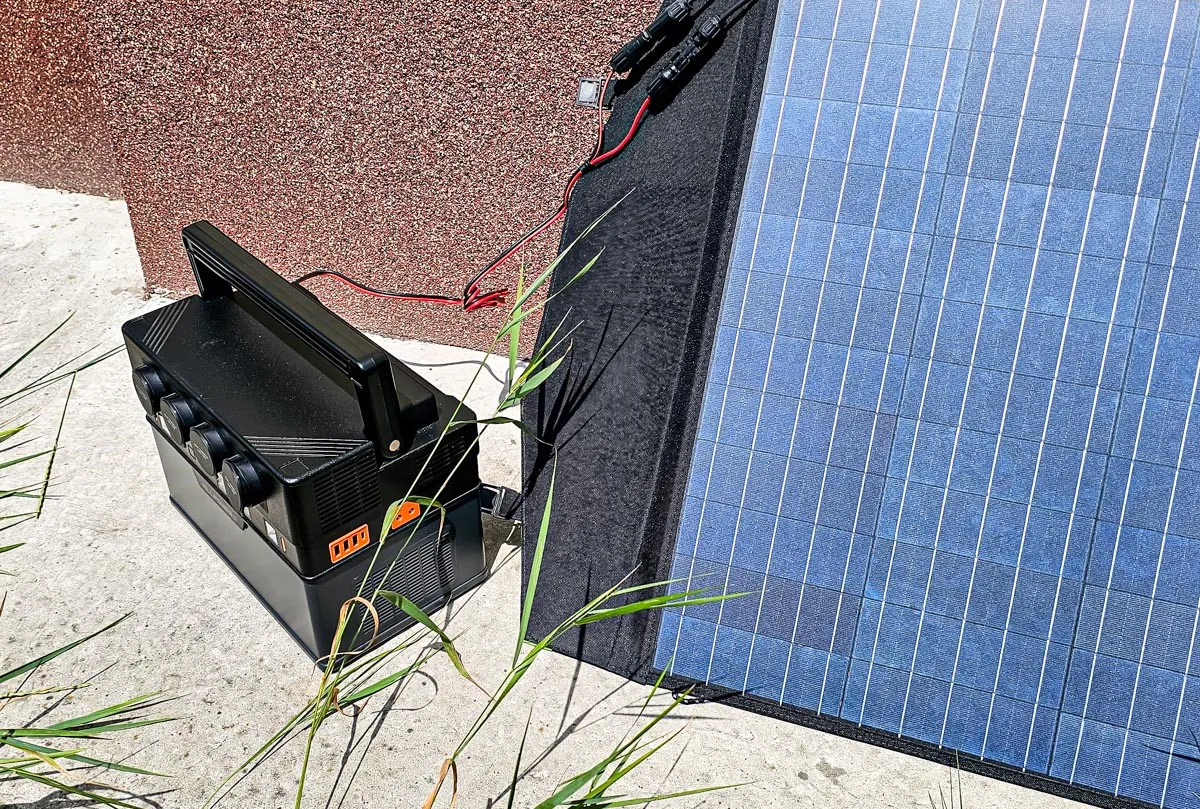
Mobile app
The charging station supports control of functions and modes via Bluetooth using a smartphone. The mobile app is available for Android and iOS:
The programme is quite simple. To pair with a smartphone, start the search mode on the charging station by pressing and holding the first function button on the left until the light starts flashing. Next, tap on the plus sign on the app’s home screen and select the station when it appears in the list of available devices.
Thanks to the mobile app, you can remotely see the current remaining battery charge and approximate station runtime before it is completely empty, control charging power and power output, as well as switch DC and AC modes on or off and activate the built-in LED lights.
Experience of using the ALLPOWERS S1500
Initially, of course, I was interested in being able to provide power for my workplace if the centralised electricity supply disappeared completely. This is what I have on my desk:
- Laptop ASUS Zenbook Pro Duo UX581
- Monitor 43″ Philips Brilliance 439P9H/00
- Peripherals connected to the monitor:
- WD Black 4TB External Desktop HDD in ARGUS chassis with separate power supply
- Lenovo 1TB external HDD with USB power supply
- Cougar Aurora S backlit keyboard
- Bloody W95 Max backlit mouse
- TP-Link Archer C7 router
All of the aforementioned devices are connected to an Eaton electrical surge protector (extension hub with protection), so I simply plugged it into one of the charging station outlets.

This is not a very economical option and generally not correct from an energy-saving point of view, because a lot of energy is wasted on extension cords, power adapters and on converting DC to AC. For example, I could swap my laptop for a standby, because it is less powerful and can simply be charged via USB, and the router can be powered directly from the station via a 12V DC line. Undoubtedly, that’s what I would do in the event of a prolonged mains power outage. But fortunately, no such apocalypse has happened in Ukraine. Therefore, my task in this test was to put the maximum load on the power station during work activities to find out how long it would last in such a mode.
The result is:
- Start of the test at 11:30 – station charge 100%
- Total power of the consumers when the equipment is switched on: up to 150W, in operation: 70-90W
- End of test at 19:00 – charging station 30% – total time 7 hours 30 minutes
Conclusion: with the ALLPOWERS S1500, I can power all the equipment I need to work during the day without having to deny myself the comfort of a large monitor and a keyboard and mouse. And if I switch completely to my standby realme Book laptop and do without external peripherals, I would have enough power for 3-4 days on a single battery charge.
The next series of tests I conducted in a countryside private house. I wondered if I could run some vital appliances and household devices and how long they would be able to run on power from the charging station.
The following test involving an Indesit WISL 105 X washing machine did not end very well. The machine started, the washing cycle started, the machine pumped in water, the power consumption at this time was around 80-90 watts, but when the drum started spinning, the charging station gave an overload error and the washing process stopped. After studying the specifications of the WISL 105 X, it turned out that the operating power of this washing machine is 1850 watts. So – no surprise, it is clear that the power output is not sufficient for normal washing machine operation, and this test was doomed to fail. But, if your washing machine’s power output is less than 1500W, I believe it will most likely work fine when connected to the ALLPOWERS S1500 charging station. Unfortunately, I didn’t have a less powerful washing machine to perform a similar test, so sorry, it is what it is.
Next it was the turn of the two-compartment refrigerator! And in this test, the charging station did quite well. The power consumption during operation of the refrigerator’s compressor was 170-180 W, and a fully charged station could operate continuously for around 5 hours in this mode. However, since the refrigerator is switched on for cooling once every 10-15 minutes and operates in this mode for about 2 minutes, it is 12-15 minutes per hour, so from the charging station the refrigerator could operate in normal mode for about a day.
On the manufacturer’s official website you can find some information regarding how long the appliances will last if powered by ALLPOWERS S1500. After several tests I see no reason not to trust this seemingly truthful data:
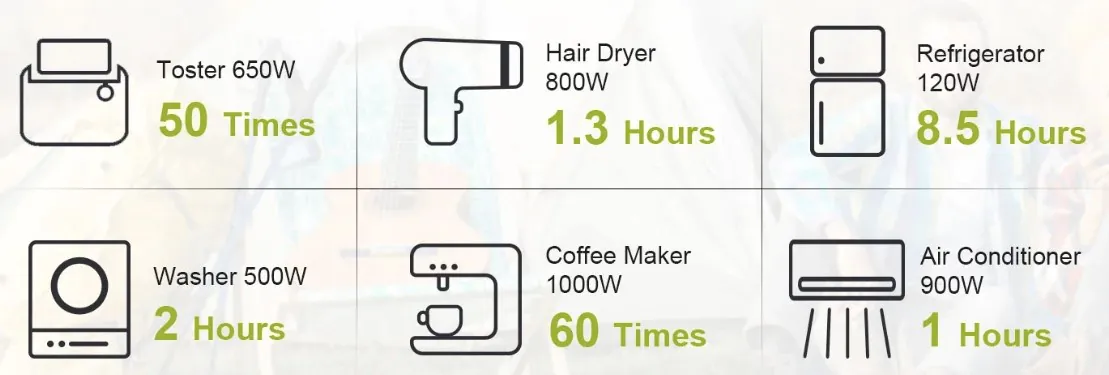
Conclusions
As we have seen, the ALLPOWERS S1500 offers quite a wide range of options to the consumer. Although the charging station has a medium capacity, it is enough for most tasks – both to charge all possible gadgets for a family of 2-3 people, and as a backup power source for a small flat or summer cottage.
 But, of course, the greatest potential of such stations is in touring use. The station is quite compact, so it doesn’t take up much space in the luggage compartment of the car.
But, of course, the greatest potential of such stations is in touring use. The station is quite compact, so it doesn’t take up much space in the luggage compartment of the car.
Where to buy ALLPOWERS S1500
- Code for a 20% discount on the official website: NVSA9PPGP9HN
- Official website: ALLPOWERS S1500 station
- Official website: ALLPOWERS S1500 station + 200W solar panels




